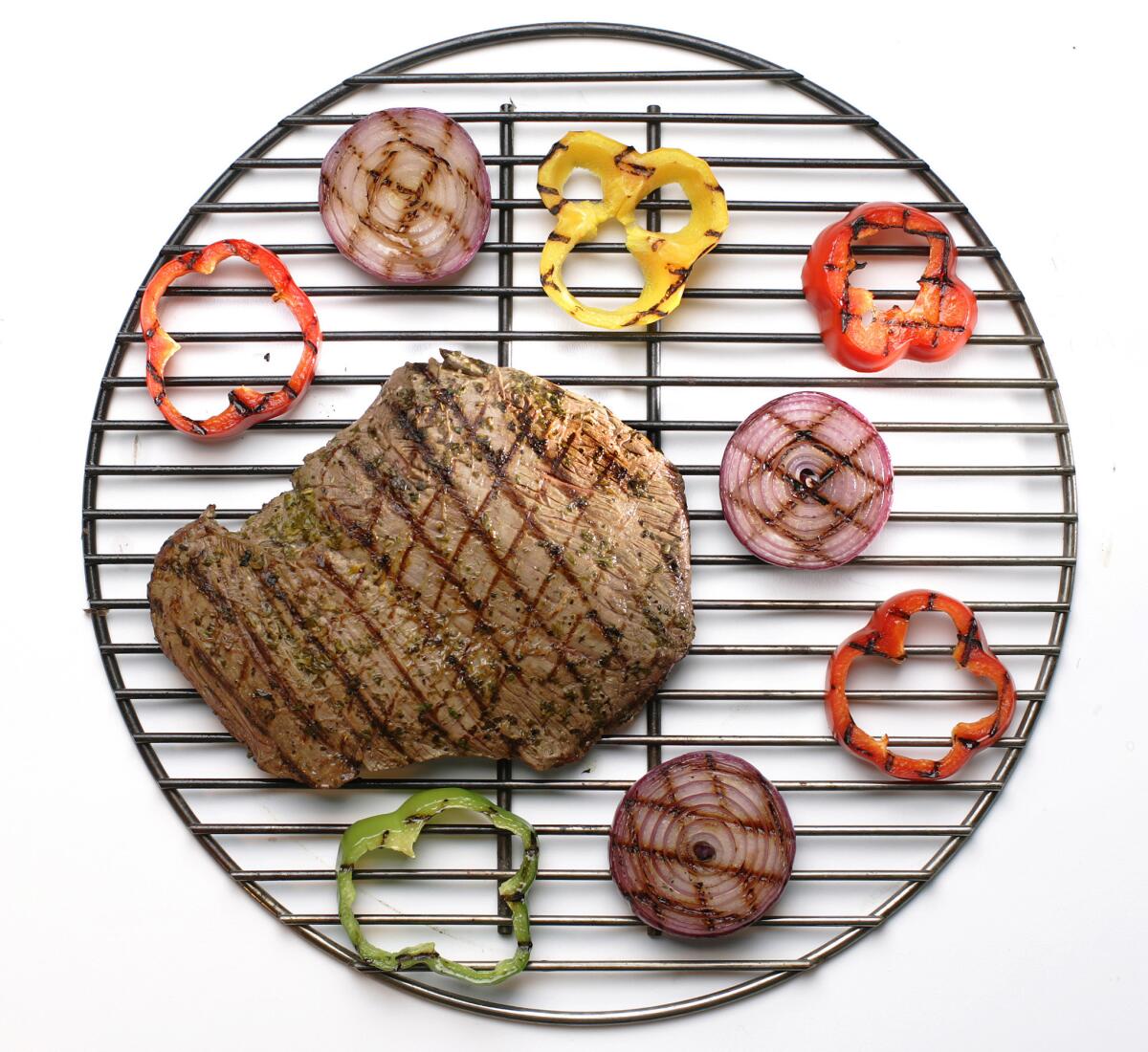Smart steak cuts for lean times

Recipe: Grilled flank steaks with chimichurri sauce
In the old days, say about this time last year, it wasn’t so hard to throw a bang-up backyard barbecue: You just picked up some nice, thick 28-day dry-aged prime New York strip steaks, lighted a fire, grilled to medium rare and then made an extended curtain call, trying to appear humble as your guests stomped and cheered.
These days, in case you haven’t heard, things are different.
But mean times don’t necessarily mean mingy meals. You just have to be a little more selective in your buying and a little more creative in your cooking. Though your $30-per-pound safety net may be frayed, rest assured that your summertime barbecues can continue -- perhaps even with applause.
Cheap steaks don’t necessarily make you a cheapskate. As they say in the Business section, it’s all about seeking out overlooked values and making the most of them. The good news is that it’s a lot easier to do that at the butcher shop than it is on the stock market.
The first step is learning a few new cuts of meat. Forget about the big names: porterhouse, New York strip, T-bone and rib-eye. If you find these at an affordable price, they’re probably going to be of such a low grade that you’re really buying the name only.
In fact, you can almost guarantee that if a cut of meat has a name you recognize from the menu at your favorite steakhouse, you’re going to have to put it behind you. Those places specialize in luxury cuts, and those almost always come at a steep price.
Instead, focus on humbler steaks: flank, tri-tip, top sirloin and sirloin tip. These cost half as much as fancier cuts in a comparable grade, but they’ve still got great flavor.
It’s not quite as easy as that though. There are a couple of catches. First, you’re probably going to need to remember all those names. As the space devoted to meat in grocery stores continues to shrink, the selection gets tighter and tighter. While a good market may stock four or five luxury cuts, it may have only two or three of the plainer varieties.
To make matters worse, there are lots of other cuts of beef that sound like they should make good grilling that don’t. These are the steaks that aren’t really steaks. Chuck, for instance, has great flavor but is so tough that it needs to be braised. The same is true of round, seven-bone, clod and the rest of their ilk.
And then there are the steaks that were previously good deals until they got discovered and popularized on restaurant menus -- skirts, hangers, flatirons.
Timing is everything
There are a couple of reasons that less-expensive steaks don’t have a reputation as luxury cuts. They have great flavor, but they can be a little tough. That’s OK; slice them thinly across the grain and no one will notice.
Also, with the exception of tri-tip, they tend to be much leaner, which means you’ve got to be spot-on with your cooking to keep them moist and juicy. Overcooking a great steak is sad; overcooking one of these is a tragedy.
That problem is squared when you’re cooking pork chops. With today’s pigs being bred and raised to produce the “other white meat,” loin chops are so lean it’s almost impossible to keep them moist and flavorful on the grill.
Fortunately, there’s our old friend the pork butt to come to the rescue, the one cut of the pig that still has a decent amount of fat. Cutting a steak from one is simple: Trim off any big chunks of exterior fat, then slice the meat across the grain into steaks that are one-half to three-fourths of an inch thick. The Italians call this cut the spalla, and I learned about it from master butcher Dario Cecchini.
You won’t be able to use the whole butt -- there’s an oddly shaped bone at one end -- but the leftover meat can be diced and used for chili or kebabs.
There are a couple of things I’ve learned over the last couple of years about grilling meat.
The first is the importance of seasoning it as soon as you get it home from the market. This is true even if you’re shopping the day before (in that case, keep it covered in the refrigerator and bring it out an hour before cooking to get it closer to room temperature).
You don’t need to use any more seasoning than you normally would, but letting the meat sit for a while before cooking dramatically improves the flavor. For beef, a simple mix of coarse salt and a generous grinding of black pepper is all it takes. For pork, I like to use a combination of salt, black pepper and fennel seeds, ground coarsely.
Another trick I’ve learned is turning steaks frequently while they’re grilling. As far as I know, food science writer Harold McGee came up with this. It goes against the previously accepted wisdom, but it seems to keep the meat more moist and evenly cooked. Just be sure to turn the meat with tongs; poking it repeatedly with a fork is a good way to lose lots of juice.
For a thin steak like a flank or spalla, the fire should be very hot, and the cooking times can be as brief as two or three minutes per turn. At that pace, you’ll probably need only two turns per side. Sear one side and then the other. On the second pass, cook the steak at a 90-degree angle to its first position to get those attractive seared grid marks. Don’t cook beyond the rare side of medium-rare or it’ll be dry and tough.
The two-stage fire
For steaks such as tri-tip that are more than three-quarters to an inch thick, remember the value of a two-stage fire. Once the coals are lighted, arrange them against one side of the barbecue so you have one area of the grill that’s very hot and another that’s more medium. (If you’re cooking with gas, turn one side to high and the other to low, or turn it off entirely.)
Sear the meat on both sides over the hot fire, then pull it over to the cooler side, turning it from time to time. You can push these to the medium side of medium-rare.
No matter the thickness of the steak, don’t forget to let it rest after you’ve removed it from the grill. This lets the meat finish cooking and the juices settle.
It might seem that it can’t make that much of a difference when a flank is only a half-inch or so thick, but it does. Carved right off the fire, the center appears spongy and juice flows everywhere. Given five minutes’ rest, the meat is cooked more evenly and there’s much less moisture loss.
When serving the leaner steaks, also remember that sauce covers a multitude of sins (both literally and figuratively). You can gain a bit more margin of error doneness-wise by spooning it over the meat. Even if it’s something as simple as good olive oil with a tease of lemon, that little bit of extra fat can be enough to rescue a flank steak that somehow went from the rare side of medium-rare to the medium side while you were finishing that last beer.
If you want to get a little fancier, what about a smear of tapenade, or a spoonful of aioli? One of my favorite steak sauces is an Argentine chimichurri, basically a kind of pesto made mostly from parsley with a to-taste assortment of other herbs tossed in. (I like a bit of mint and some dried oregano; other possibilities include dried chile, cumin and fresh oregano.)
A true chimichurri is made by whisking a quickly made brine (salmuera) into the herb mixture and letting it steep overnight. But a fast version can be made by leaving out the brine. It doesn’t seem to improve over time the way the original does, but it’s still plenty good as a last-minute finish for a steak. Brush a couple of tablespoons onto the meat before grilling as well.
Carve the meat in thin slices, cutting across the grain and holding the knife at a pretty shallow angle so you’re slicing on a deep bias. The steak will fall away in wide, thin ribbons, seared on the surface and reddish pink at the center. Spoon a little sauce down the center and pass the rest at the table.
The flavor is deep and beefy with a wild herbal overtone. And unless you tell someone how much you paid for it, they’ll never guess.
Congratulations, you’ve just won the cheap steaks sweepstakes.
More to Read
Eat your way across L.A.
Get our weekly Tasting Notes newsletter for reviews, news and more.
You may occasionally receive promotional content from the Los Angeles Times.











